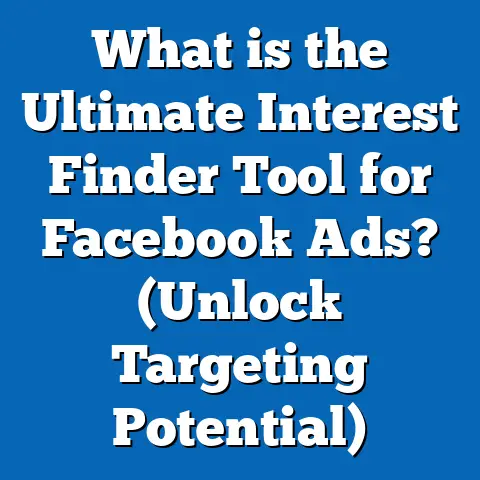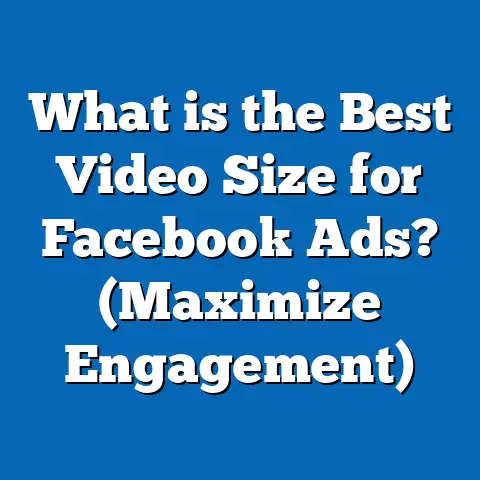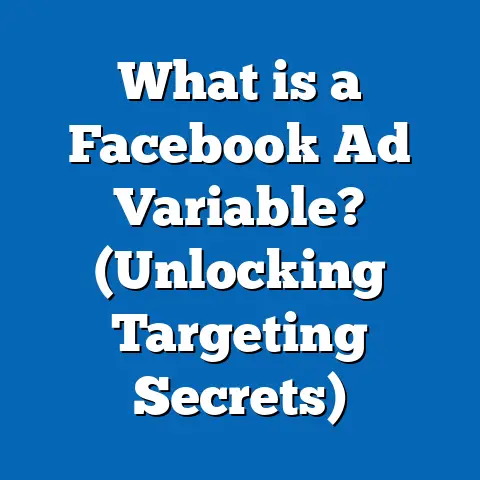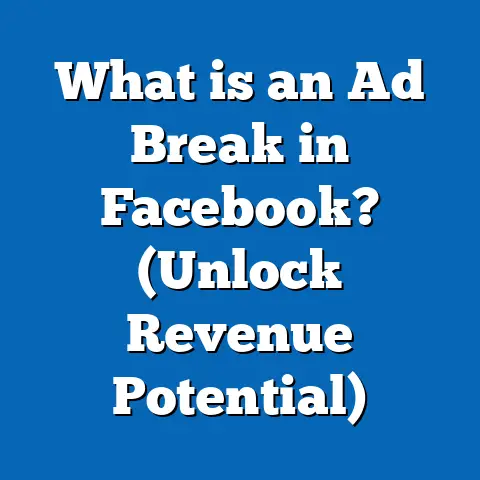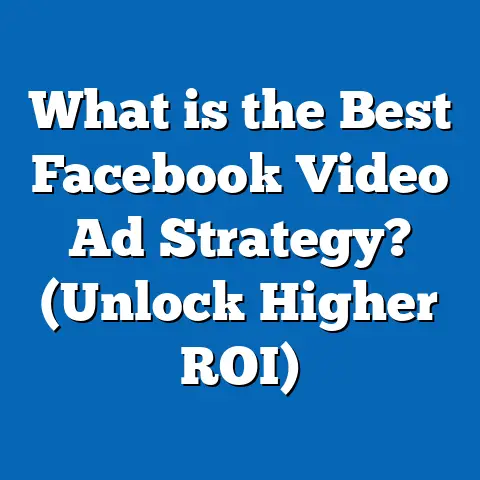What is Branded Content on Facebook? (Unlock Advertising Potential)
What is Branded Content on Facebook? (Unlock Advertising Potential)
Introduction: Why Understanding Branded Content Matters for Your Business
Health is often considered the foundation of a productive and fulfilling life. Just as maintaining good health requires the right nutrition, exercise, and rest, running a successful business depends heavily on a healthy advertising strategy. In the crowded digital marketplace, businesses must find ways to stand out and build genuine connections with audiences. Facebook’s branded content offers a unique opportunity to do just that—combining authenticity with advertising power.
Branded content allows brands to tap into trusted voices, providing real value to consumers while promoting products or services transparently. This strategy not only drives engagement but also builds long-term trust, much like how a balanced diet fuels sustainable health. Understanding the nuances of Facebook branded content can empower marketers and business owners to unlock significant advertising potential and drive measurable growth.
Understanding Branded Content on Facebook
What is Branded Content?
Branded content on Facebook refers to posts or videos created by influencers, publishers, or creators that feature a third-party brand in a clear and transparent manner. Unlike traditional advertisements created solely by brands, branded content originates from creators and often feels more organic and trustworthy.
Facebook defines branded content as content that “features a third party who has paid for or provided value in exchange for content creation.” To maintain transparency, Facebook requires creators to use the “Paid Partnership” tag, which signals to users that the post is sponsored.
Branded content can take many forms:
- Product reviews or demonstrations
- Tutorials featuring a brand’s products
- Lifestyle posts incorporating branded items
- Event coverage sponsored by a brand
Why Transparency Matters
Transparency is crucial in branded content because it maintains audience trust. Facebook’s “Paid Partnership” tag clearly communicates to users when content includes sponsorships. This openness prevents misleading advertising and helps maintain credibility for both creators and brands.
Differences Between Branded Content and Traditional Ads
| Feature | Traditional Ads | Branded Content |
|---|---|---|
| Creator | Brand’s marketing team | Influencer or creator |
| Content Style | Promotional, polished | Organic, authentic |
| Audience Perception | Seen as advertisement | Seen as recommendation |
| Transparency Requirement | Mandatory disclosure | Mandatory “Paid Partnership” tag |
| Engagement Potential | Moderate | Often higher |
Branded content’s authenticity often leads to better engagement and trust compared to traditional ads.
The Impact of Branded Content in Advertising
Why Branded Content Works
Consumers today are increasingly skeptical of direct advertisements. According to a 2023 Nielsen report, traditional ads are trusted by only 33% of consumers, while 70% trust influencer recommendations or branded content. This shift highlights why marketers are investing heavily in branded collaborations.
Branded content works because it:
- Feels less like a sales pitch and more like a trusted recommendation.
- Integrates seamlessly into social feeds.
- Leverages creators’ existing relationships with their audiences.
- Provides measurable engagement and conversion metrics.
Key Statistics About Facebook Branded Content
- Facebook reports that branded content posts have up to 30% higher engagement than equivalent brand-only posts.
- Sponsored posts with the “Paid Partnership” tag have shown 25% higher click-through rates compared to non-tagged influencer posts.
- Around 60% of marketers say branded content on Facebook provides better ROI than other social advertising formats (Source: Social Media Examiner, 2024).
Case Study: Beauty Brand Y’s Influencer Campaign
Beauty Brand Y partnered with 15 beauty influencers for a new skincare line launch. Each influencer created tutorials using the products, tagged with “Paid Partnership,” and shared authentic reviews.
- Results:
- 40% increase in product sales over six weeks.
- Average engagement rate per post was 9%, nearly triple the brand’s usual organic posts.
- Brand awareness improved by 20% based on Facebook Brand Lift studies.
- The campaign generated over 2 million video views combined.
The success of this campaign demonstrates how blending authentic content with paid promotion drives both awareness and sales.
How Facebook Supports Branded Content Creators and Businesses
Tools for Managing Branded Content
Facebook provides several tools designed specifically for branded content management:
- Paid Partnership Tag: This functionality allows creators to tag their business partners directly in their posts or videos. The tag displays “Paid Partnership with [Brand]” at the top of the post.
- Branded Content Ads: Brands can turn branded content posts into ads through Facebook Ads Manager. This extends the organic reach of creator posts by targeting specific demographics.
- Creator Studio Insights: Both creators and businesses can access detailed analytics including reach, engagement, demographics, and video metrics.
- Rights Manager: Helps brands protect their intellectual property by managing ownership rights of branded content assets on Facebook.
- Branded Content Approvals: Brands can approve or decline partnership requests from creators before branded content goes live.
How to Get Started with Branded Content on Facebook
To use branded content features effectively:
- Enable Branded Content Tagging: Creators need to enable this feature in their Page settings.
- Establish Partnerships: Collaborate with relevant creators aligned with your brand values.
- Develop Content Briefs: Provide guidelines but allow creative freedom for authenticity.
- Tag Partners Properly: Use the “Paid Partnership” label for transparency.
- Use Ads Manager: Boost or promote top-performing posts.
- Monitor Performance: Use analytics tools to track success and make data-driven decisions.
Deep Dive: Types of Branded Content on Facebook
Video Content
Video is one of the most engaging formats on Facebook. Branded videos might include tutorials, product demos, behind-the-scenes footage, interviews, or event highlights.
- Videos with branded content tags see up to 35% higher watch times than standard videos.
- Live videos from creators showing product use generate real-time engagement and feedback.
Image Posts
Images featuring products integrated naturally into lifestyle shots or influencer posts remain popular. Using high-quality photos that tell a story helps build emotional connection with audiences.
Stories
Facebook Stories offer ephemeral, full-screen content ideal for quick product showcases or time-sensitive promotions. Stories with branded content tags can be boosted similarly to regular posts.
Carousel Posts
Carousel ads allow multiple images or videos in one post. Creators can showcase various products or features in a single branded content post to increase interaction.
Creating Effective Branded Content: Detailed Best Practices
Choosing the Right Creators
- Look for creators whose audience matches your target demographic.
- Analyze their engagement rates—not just follower counts.
- Prioritize authenticity; fans can spot forced endorsements easily.
- Consider micro-influencers (10K–100K followers) for niche markets; they tend to have higher engagement rates.
Crafting Authentic Messaging
- Encourage storytelling rather than hard selling.
- Use product placement naturally within creator’s usual style.
- Avoid overly scripted messages; allow creators creative freedom.
Compliance with Facebook Policies
- Always use the “Paid Partnership” tag.
- Disclose sponsored content clearly according to FTC guidelines.
- Avoid prohibited content such as misleading claims.
Timing and Frequency
- Space out branded content posts to avoid audience fatigue.
- Align posts with product launches or seasonal campaigns for relevancy.
Advanced Strategies: Boosting Branded Content Performance
Using Data for Smarter Targeting
Facebook’s targeting options allow businesses to reach precise segments:
- Use custom audiences based on website visitors or app users.
- Retarget users who engaged with previous branded content posts.
- Create lookalike audiences based on high-value customers for broader reach.
Example: A fitness brand retargeted users who watched over 50% of its workout tutorial videos featuring sponsored supplements, achieving up to 20% higher conversion rates.
Testing and Optimization
- A/B test different creatives, captions, and call-to-actions.
- Analyze performance metrics regularly to identify winning formats.
- Use Facebook’s split testing tool in Ads Manager for systematic comparison.
Integrating With Other Marketing Channels
- Embed branded content videos on your website or landing pages.
- Cross-promote Instagram influencer posts simultaneously.
- Include links in email newsletters referencing creator content.
This multi-channel approach reinforces messaging and improves conversion potential.
Case Studies: Real World Examples of Successful Branded Content Campaigns on Facebook
Case Study 1: Outdoor Gear Brand Z’s Multi-Creator Campaign
Brand Z worked with 20 outdoor enthusiasts who posted authentic adventure stories featuring its gear. They used Facebook’s branded content tools combined with paid boosts targeting outdoor activity lovers.
Outcomes:
- Reach exceeded 5 million users across all posts.
- Engagement rates averaged 7%, well above industry average (1–3%).
- Online sales increased by 33% over three months.
Brand Z credited its transparent partnerships and natural storytelling as key to success.
Case Study 2: Tech Startup Launches New Gadget Through Influencer Reviews
A startup launched a new smart home device by partnering with tech reviewers who created unboxing and review videos tagged with paid partnership labels.
Results:
- Videos collectively garnered over 1 million views within two weeks.
- Conversion tracking showed a direct correlation between video views and pre-orders.
- Feedback from comments helped improve product features in real time.
This example shows how branded content can accelerate product adoption when combined with detailed analytics.
Comparing Facebook Branded Content with Other Platforms: A Closer Look
Instagram vs. Facebook Branded Content
Instagram is often seen as more influencer-centric due to its visual nature and younger user base. However:
- Instagram also supports “Paid Partnership” tags.
- Instagram Stories allow swipe-up links for direct conversions (available for accounts with 10K+ followers).
- Instagram Reels offer short-form video opportunities but limited ad boosting options compared to Facebook.
Facebook offers more sophisticated targeting through Ads Manager and greater variety in post formats like carousel ads.
YouTube vs. Facebook Branded Content
YouTube influencers frequently disclose sponsorships verbally or in descriptions but lack native “paid partnership” tagging like Facebook. YouTube excels in long-form video but has more limited native ad boosting tied directly to branded content posts.
TikTok vs. Facebook Branded Content
TikTok relies heavily on viral challenges and native videos but lacks formal branded content tools comparable to Facebook’s comprehensive system. TikTok’s algorithm favors organic virality but provides fewer options for paid amplification linked directly to creator partnerships.
Legal and Ethical Considerations in Branded Content Marketing
Disclosure Requirements
In the U.S., Federal Trade Commission (FTC) guidelines require clear disclosures of sponsored content. Using Facebook’s built-in “Paid Partnership” tag helps meet these guidelines but marketers should also:
- Instruct creators to mention sponsorship verbally if possible.
- Avoid ambiguous language that could mislead viewers.
Protecting Brand Reputation
- Vet creators carefully before partnerships.
- Monitor content for compliance with brand values.
- Respond quickly to any negative feedback related to sponsored posts.
Measuring Success: Metrics That Matter for Facebook Branded Content Campaigns
| Metric | What It Measures | Why It Matters |
|---|---|---|
| Engagement Rate | Likes, comments, shares per post | Indicates audience interest |
| Reach & Impressions | Number of unique users who saw content | Measures campaign visibility |
| Video Watch Time | Average time spent watching videos | Shows content relevance |
| Click-Through Rate | Percentage clicking links | Tracks interest in offers |
| Conversion Rate | Actions like purchases or sign-ups | Measures ROI |
| Brand Lift Studies | Changes in awareness/perception | Quantifies brand impact |
Using these metrics together provides a holistic view of campaign performance beyond vanity numbers like follower count.
Practical Tips for Marketers Starting with Facebook Branded Content
- Start Small: Pilot campaigns with micro-influencers before scaling up.
- Set Clear KPIs: Define goals—awareness, engagement, conversions—to measure success accurately.
- Focus on Storytelling: Encourage creators to tell authentic stories that resonate emotionally.
- Use Data Continuously: Monitor results closely and adjust strategy as needed.
- Stay Updated: Follow changes in Facebook’s branded content policies and features regularly.
Future Trends in Facebook Branded Content Marketing
Increased Use of AI for Personalization
Artificial intelligence will enable hyper-personalized branded content tailored to individual user preferences, improving relevance and engagement.
Growth of Video Commerce
Shoppable videos through branded content will grow, allowing users to purchase products directly from videos without leaving Facebook.
Expansion of AR/VR Experiences
Augmented reality filters or virtual reality events co-created by brands and influencers will offer immersive branded experiences on Facebook platforms like Meta Horizon Worlds.
Summary: Unlocking the Power of Facebook Branded Content
Facebook branded content bridges the gap between authentic creator storytelling and strategic brand advertising. By understanding its features, leveraging data-driven targeting, respecting transparency guidelines, and integrating across channels, marketers can unlock substantial advertising potential.
Key takeaways:
- Use the “Paid Partnership” tag consistently for transparency and trust.
- Collaborate authentically with creators aligned to your brand values.
- Promote high-performing branded content through paid boosts for wider reach.
- Measure impact using comprehensive metrics including engagement, conversions, and brand lift studies.
- Stay adaptable as new technologies and trends shape the future of branded marketing.

